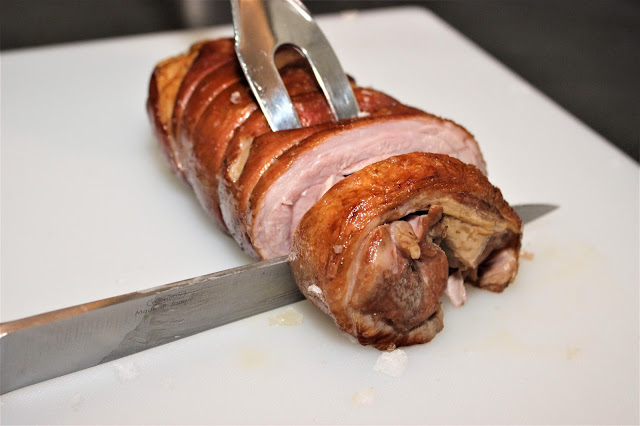In other news, we've cooked lamb breast. This is one of those times when a water bath excels because this particular cut of meat is full of flavour but it's tough like Vin Diesel so benefits from long slow cooking. Vin Diesel on the other hand probably doesn't.
Only one of those things is relevant.
Having only ever cooked it on the hob at a high heat, I knew it was a tough piece of meat but I didn't want to crank up the water bath too high for risk of wringing the juices out of it. Conversely, too low and - Vin Diesel. So off we went on a knife-edged mystery tour based on nothing but a hunch.
Vital statistics : 60 degrees for 24 hours
Just to clear this one up, I don't own a grecian urn, that's a pestle and mortar at the top.
Ignore the temperature readout that looks a bit kaleidoscopic. I set it to 61 before knocking it down to 60 in a crisis of confidence so it was still cooling down when I put the lamb in.
And this is it out of the water bath.
If you've read the ribeye post, you'll have lived through the realisation that I've got a griffin claw hand. Yep, still got it. I'm like a modern day Jeremy Beadle.
Again with the salt. I'll get round to cooking with salt in the bag to see how it works out but I'm worried it might draw out too much water leaving the meat dry. For things you're cooking for short periods, not so much of a problem but for a 24 hour cook, it might be more of an issue.
Short answer - I put some salt on it.
Two words - lamb bacon.
And this is the final version.
Now this isn't strictly a sous vide thing, but if you're going to slice something rolled, don't do as I did. Slice it, then remove the string to stop it collapsing. For those of you who aren't as moronic as I am, you'll have learnt this before the age of 47.
And this is where the good and bad starts but stick with me. There's a white layer, a membrane that turns nicely soft when cooked at higher temperatures but it didn't doing it this way. You can see it in the next photos but I'll come back to that later.

So here's the scoop. The meat and fat were wonderful. Really soft and juicy and the lamb flavour was well up there. My lovely girlfriend liked it so much we're having it again this weekend. I know it'll sound weird but it was so beefy, I wanted to put mustard with it and we're having it with chips on Saturday. I know that'll come across as odd, but sometimes odd things work. Like lamb and chips or Ant & Dec.
If I was colouring it again I'd either give it even more colour or slice it then fry it because lamb fat turns deliciously smoky under heat so surface area could be the killer here. That's another bit I'll come back to.
That white membrane though. It's edible but not fab but because the meat's so soft it's a cinch to remove. My thinking is time or heat could soften it so you don't have to remove it. I know heat will wring some of the moisture out but I'm not sure time will do it at these temperatures. There's a chance this could be improved though so I've got a plan.
Buy another. Cut it in two and put one piece in one water bath for longer and the other in the other water bath at a higher temperature. Time it so they're ready a the same time, then try the slicing/frying thing and see how they turn out. The downside is I'll be doing this without my girlfriend here so I'll be taking the photos on my phone rather than her beastly device but hey, appreciate the glorious selflessness here.
Stand by for an update in a couple of weeks when I potentially make this worse.
Update
Okay, I've re-done it to an extent. My girlfriend wanted this lamb again and not wanting to disappoint, I did it exactly the same way but sliced it and fried the flat sides as well if you see what I mean.
The photos won't tell you much but you can compare the golden version against the au-naturelle pieces above.
Straight off they're much more appealing to look at but this isn't a beauty contest, it's how they taste. What I can't tell you (yet) is what it's like cooked at a higher temperature but trust me, whatever temperature you cook it at, fry every damned surface you can get into a pan. This is waaay better to eat than the previous attempts. Trust us, don't skip this step, it's fab.
Update 2
Being the kind and helpful soul that I am, I've tried this at a higher temperature to see if it'd melt that white membrane and you know what - it does. Cooked for 18 hours at 70 degrees makes it gelatinous and much more of a joy to eat. There is a down side though.
The meat's denser. It's not tough and it's still very moist thanks to the fat content but it is a tiny bit denser in texture than the 60 degree version. It's more meaty in a way but I think I prefer the melt-in-your-mouth experience the lower temperature achieves. This is cooking it for the two of us though ; if I was running a restaurant and expected people to pay, I'd go 70 all day long.
So there's your choice - if you don't mind hoiking out the white bit, go for 60. If you want that bit cooked to melting and don't mind the textural trade-off, go for 70.

























No comments:
Post a Comment